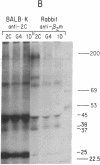Abstract
Clones of cytotoxic T lymphocytes (CTL) differ in their specific reactivity with diverse target cell antigens. To learn about the uniqueness of individual CTL clones we injected rats and mice with cloned CTL in an effort to prepare clone-specific antisera and to analyze the CTL surface molecules that were immunoprecipitated by these antisera. Three clones were studied. They were all derived from BALB.B mice and were specific for antigens encoded by the major histocompatibility complex of the H-2d haplotype. Antisera raised in rats against individual clones contained antibodies to lymphocyte function-associated antigen type 1 (LFA-1) and inhibited the cytotoxic activity of all of the clones. In contrast, BALB/c and BALB.K mice injected with individual clones consistently yielded alloantisera that were clone specific in their ability to inhibit CTL-mediated lysis of target cells (P815). In addition, these alloantisera immunoprecipitated from extracts of 125I-radiolabeled CTL a disulfide-bonded dimer consisting of approximately equal to 45-kilodalton subunits. This dimer resembles the putative T-cell antigen-recognition receptor recently identified in several laboratories. The alloantisera also immunoprecipitated CTL surface molecules that were associated with beta 2-microglobulin and that differed in apparent molecular mass (37-38 kilodaltons) in different clones.
Full text
PDF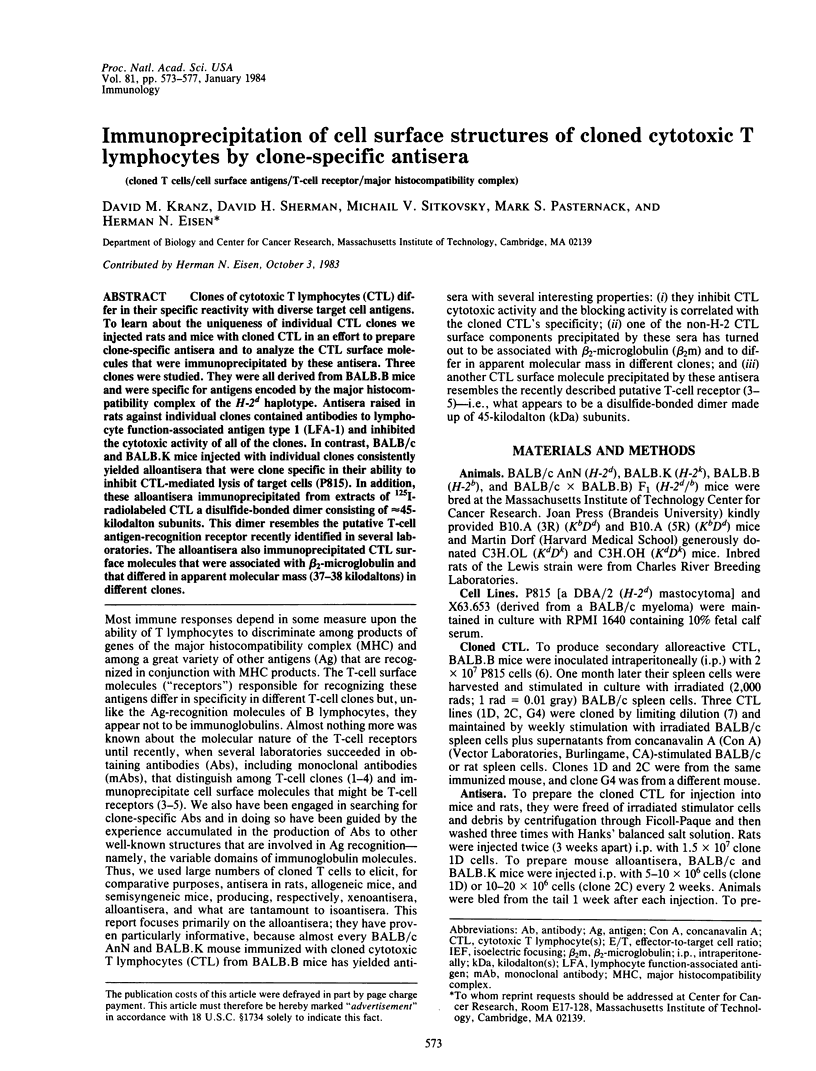
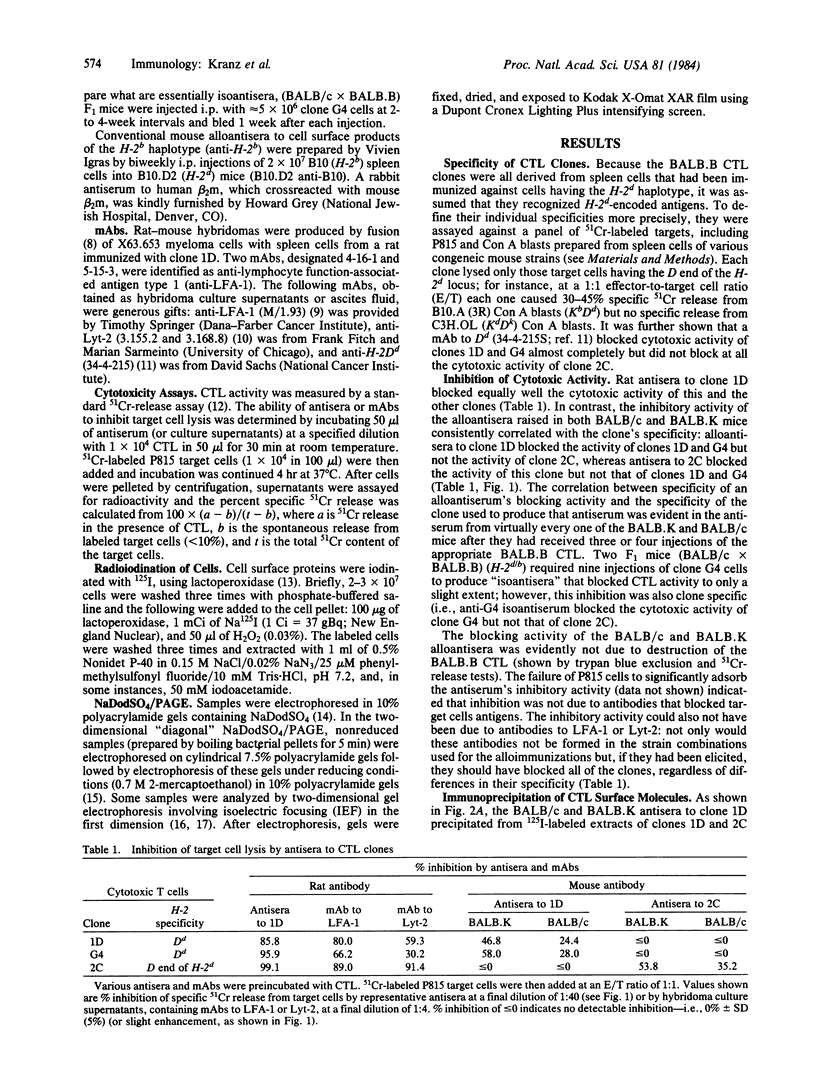
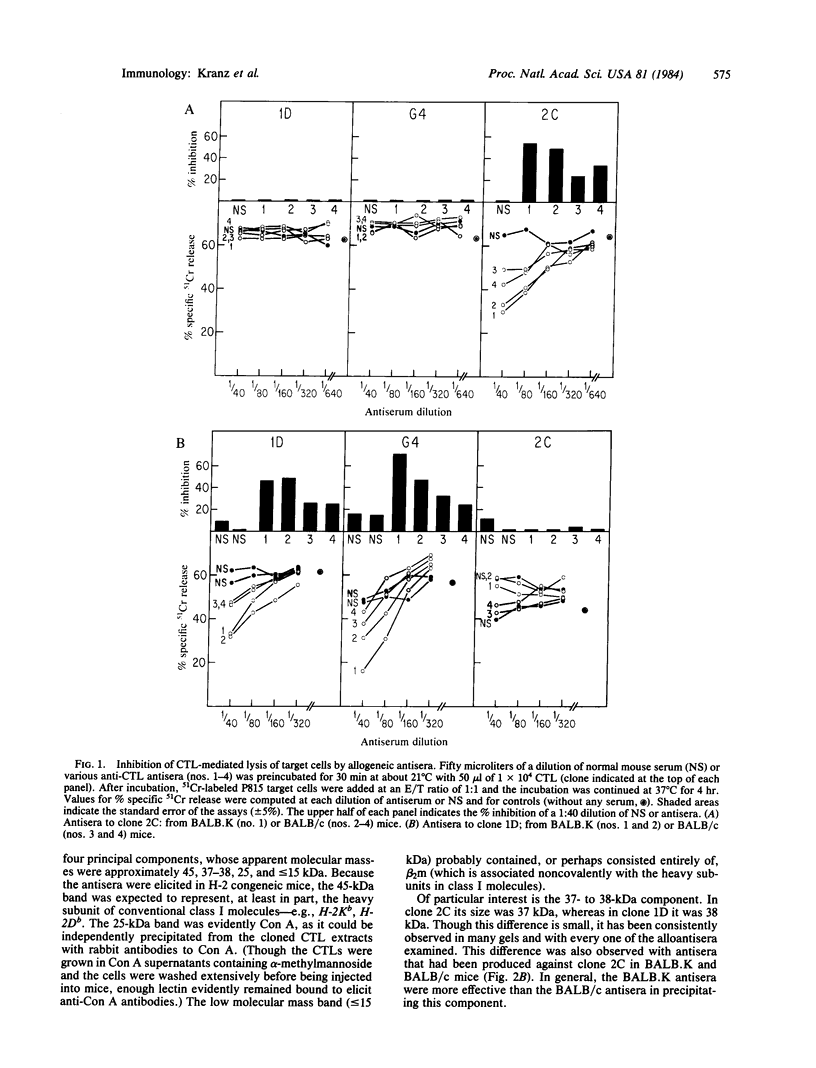
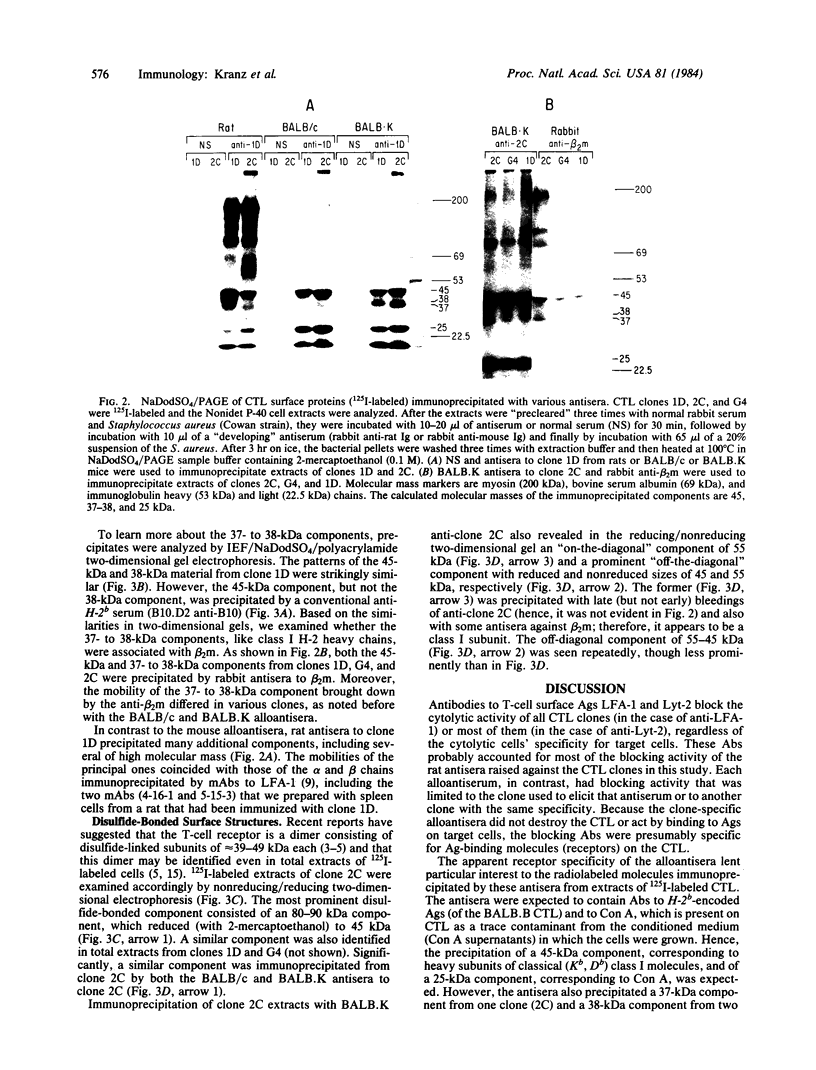
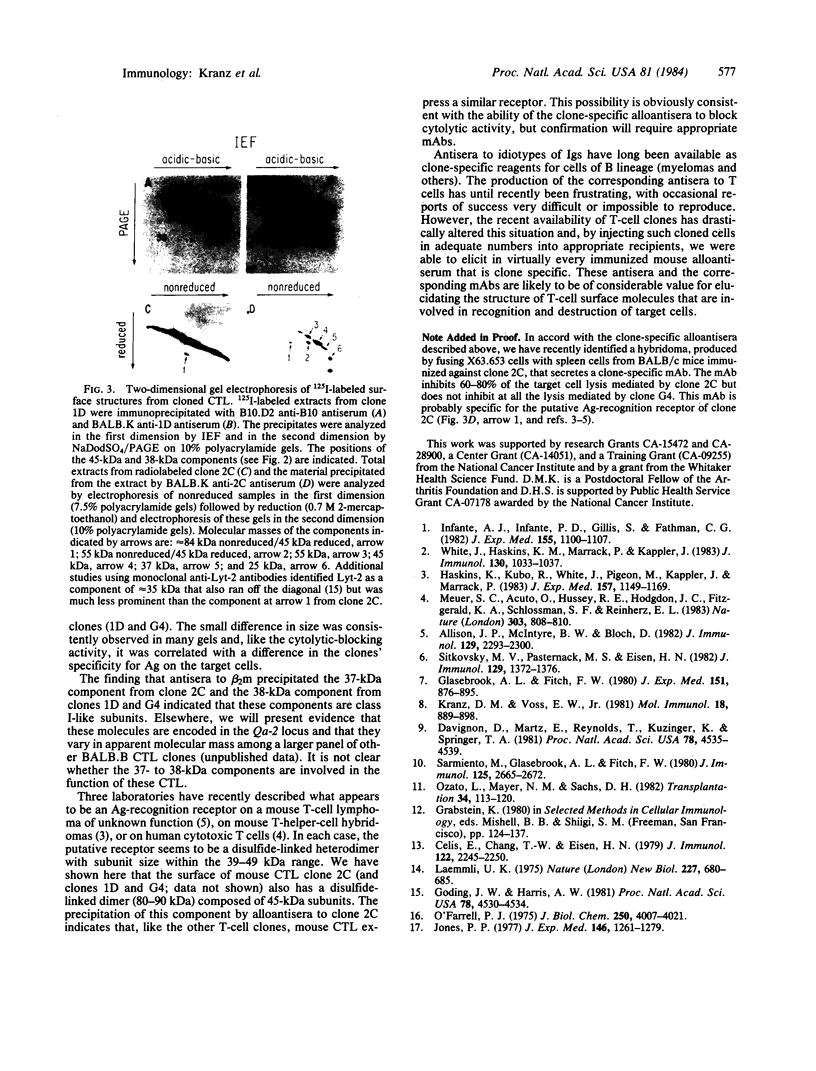
Images in this article
Selected References
These references are in PubMed. This may not be the complete list of references from this article.
- Allison J. P., McIntyre B. W., Bloch D. Tumor-specific antigen of murine T-lymphoma defined with monoclonal antibody. J Immunol. 1982 Nov;129(5):2293–2300. [PubMed] [Google Scholar]
- Celis E., Chang T. W., Eisen H. N. Cyclical changes in susceptibility of a myeloma tumor (LPC-1) to immune destruction. III. Periodic production of a cell surface glycoprotein and changes in reactivity with cytotoxic T cells and anti-H-2d sera. J Immunol. 1979 Jun;122(6):2245–2250. [PubMed] [Google Scholar]
- Davignon D., Martz E., Reynolds T., Kürzinger K., Springer T. A. Lymphocyte function-associated antigen 1 (LFA-1): a surface antigen distinct from Lyt-2,3 that participates in T lymphocyte-mediated killing. Proc Natl Acad Sci U S A. 1981 Jul;78(7):4535–4539. doi: 10.1073/pnas.78.7.4535. [DOI] [PMC free article] [PubMed] [Google Scholar]
- Glasebrook A. L., Fitch F. W. Alloreactive cloned T cell lines. I. Interactions between cloned amplifier and cytolytic T cell lines. J Exp Med. 1980 Apr 1;151(4):876–895. doi: 10.1084/jem.151.4.876. [DOI] [PMC free article] [PubMed] [Google Scholar]
- Goding J. W., Harris A. W. Subunit structure of cell surface proteins: disulfide bonding in antigen receptors, Ly-2/3 antigens, and transferrin receptors of murine T and B lymphocytes. Proc Natl Acad Sci U S A. 1981 Jul;78(7):4530–4534. doi: 10.1073/pnas.78.7.4530. [DOI] [PMC free article] [PubMed] [Google Scholar]
- Haskins K., Kubo R., White J., Pigeon M., Kappler J., Marrack P. The major histocompatibility complex-restricted antigen receptor on T cells. I. Isolation with a monoclonal antibody. J Exp Med. 1983 Apr 1;157(4):1149–1169. doi: 10.1084/jem.157.4.1149. [DOI] [PMC free article] [PubMed] [Google Scholar]
- Infante A. J., Infante P. D., Gillis S., Fathman C. G. Definition of T cell idiotypes using anti-idiotypic antisera produced by immunization with T cell clones. J Exp Med. 1982 Apr 1;155(4):1100–1107. doi: 10.1084/jem.155.4.1100. [DOI] [PMC free article] [PubMed] [Google Scholar]
- Jones P. P. Analysis of H-2 and Ia molecules by two-dimensional gel electrophoresis. J Exp Med. 1977 Nov 1;146(5):1261–1279. doi: 10.1084/jem.146.5.1261. [DOI] [PMC free article] [PubMed] [Google Scholar]
- Kranz D. M., Voss E. W., Jr Partial elucidation of an anti-hapten repertoire in BALB/c mice: comparative characterization of several monoclonal anti-fluorescyl antibodies. Mol Immunol. 1981 Oct;18(10):889–898. doi: 10.1016/0161-5890(81)90012-2. [DOI] [PubMed] [Google Scholar]
- Laemmli U. K. Cleavage of structural proteins during the assembly of the head of bacteriophage T4. Nature. 1970 Aug 15;227(5259):680–685. doi: 10.1038/227680a0. [DOI] [PubMed] [Google Scholar]
- Meuer S. C., Acuto O., Hussey R. E., Hodgdon J. C., Fitzgerald K. A., Schlossman S. F., Reinherz E. L. Evidence for the T3-associated 90K heterodimer as the T-cell antigen receptor. Nature. 1983 Jun 30;303(5920):808–810. doi: 10.1038/303808a0. [DOI] [PubMed] [Google Scholar]
- O'Farrell P. H. High resolution two-dimensional electrophoresis of proteins. J Biol Chem. 1975 May 25;250(10):4007–4021. [PMC free article] [PubMed] [Google Scholar]
- Ozato K., Mayer N. M., Sachs D. H. Monoclonal antibodies to mouse major histocompatibility complex antigens. Transplantation. 1982 Sep;34(3):113–120. doi: 10.1097/00007890-198209000-00001. [DOI] [PubMed] [Google Scholar]
- Sarmiento M., Glasebrook A. L., Fitch F. W. IgG or IgM monoclonal antibodies reactive with different determinants on the molecular complex bearing Lyt 2 antigen block T cell-mediated cytolysis in the absence of complement. J Immunol. 1980 Dec;125(6):2665–2672. [PubMed] [Google Scholar]
- Sitkovsky M. V., Pasternack M. S., Eisen H. N. Inhibition of cytotoxic T lymphocyte activity by concanavalin A. J Immunol. 1982 Oct;129(4):1372–1376. [PubMed] [Google Scholar]
- White J., Haskins K. M., Marrack P., Kappler J. Use of I region-restricted, antigen-specific T cell hybridomas to produce idiotypically specific anti-receptor antibodies. J Immunol. 1983 Mar;130(3):1033–1037. [PubMed] [Google Scholar]





